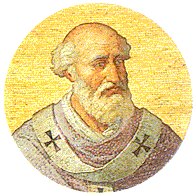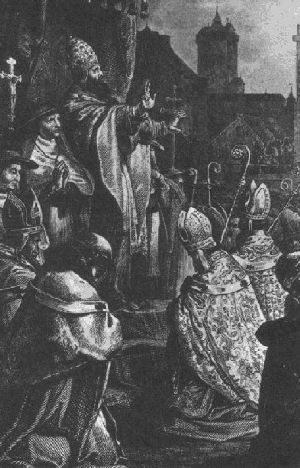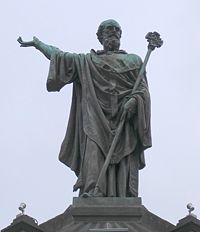Difference between revisions of "Urban II" - New World Encyclopedia
(credit Wiki) |
(claimed) |
||
| Line 1: | Line 1: | ||
| + | {{Claimed}} | ||
{{Infobox Pope| | {{Infobox Pope| | ||
English name=Urban II| | English name=Urban II| | ||
Revision as of 03:21, 2 October 2007
| Urban II | |
|---|---|

| |
| Birth name | Otho of Lagery |
| Papacy began | March, 1088 |
| Papacy ended | July 29, 1099 |
| Predecessor | Victor III |
| Successor | Paschal II |
| Born | 1042 Lagery, France |
| Died | July 29 1099 Rome, Italy |
| Other popes named Urban | |
| Styles of Pope Urban II | |

| |
| Reference style | His Holiness |
| Spoken style | Your Holiness |
| Religious style | Holy Father |
| Posthumous style | Blessed |
Pope Urban II (1042 – July 29, 1099), born Otho of Lagery (alternatively: Otto or Odo), was Pope from 1088 to July 29, 1099. He is most known for starting the First Crusade (1095–99) and setting up the modern day Roman Curia, in the manner of a royal court, to help run the Church.
He was born into nobility in France at Lagery (near Châtillon-sur-Marne) and was church-educated. He was archdeacon of Rheims when, under the influence of his teacher Bruno of Cologne, he resigned and entered the monastery of Cluny where he rose to be prior. In 1078, Pope Gregory VII (1073–85) summoned him to Italy and made him cardinal-bishop of Ostia.
He was one of the most prominent and active supporters of the Gregorian reforms, especially as legate in Germany in 1084, and was among the few whom Gregory VII nominated as possible successors to be Pope. Desiderius, abbot of Monte Cassino, who became Pope Victor III (1086–87) was chosen Pope initially, but after his short reign Odo was elected Pope Urban II by acclamation (March 1088) at a small meeting of cardinals and other prelates held in Terracina. He took up the policies of Pope Gregory VII, and while pursuing them with determination, showed greater flexibility, and diplomatic finesse. At the outset he had to reckon with the presence of the powerful antipope Clement III (1080, 1084–1100) in Rome; but a series of well-attended synods held in Rome, Amalfi, Benevento, and Troia supported him in renewed declarations against simony, lay investiture, and clerical marriages, and a continued opposition to Emperor Henry IV (1056–1105).
In accordance with this last policy, the marriage of the countess Matilda of Tuscany with Guelph of Bavaria was promoted, Prince Conrad was helped in his rebellion against his father and crowned King of the Romans at Milan in 1093, and the Empress (Adelaide or Praxedes) encouraged in her charges against her husband. In a protracted struggle also with Philip I of France (1060–1108), whom he had excommunicated for his adulterous marriage to Bertrade de Montfort, Urban II finally proved victorious.
Urban II had much correspondence with Archbishop Anselm of Canterbury, to whom he extended an order to come urgently to Rome just after the Archbishop's first flight from England, and earlier gave his approval to Anselm's work De Incarnatione Verbi (The Incarnation of the Word).
Crusades
Urban II's crusading movement took its first public shape at the Council of Piacenza, where in March 1095 Urban II received an ambassador from the Byzantine Emperor Alexios I Komnenos (1081–1118), asking for help against the Muslims. A great council met, attended by numerous Italian, Burgundian, and French bishops in such vast numbers it had to be held in the open air outside the city. At the Council of Clermont held in November of the same year, Urban II's sermon proved the most effective single speech in European history, as he summoned the attending nobility and the people to wrestle the Holy Land from the hands of the Seljuk Turks:
"I, or rather the Lord, beseech you as Christ's heralds to publish this everywhere and to persuade all people of whatever rank, foot-soldiers and knights, poor and rich, to carry aid promptly to those Christians and to destroy that vile race from the lands of our friends. I say this to those who are present, it meant also for those who are absent. Moreover, Christ commands it." [1]
According to the chronicler Robert the Monk, Urban II quoted that
"[...] this land which you inhabit, shut in on all sides by the seas and surrounded by the mountain peaks, is too narrow for your large population; nor does it abound in wealth; and it furnishes scarcely food enough for its cultivators. Hence it is that you murder one another, that you wage war, and that frequently you perish by mutual wounds. Let therefore hatred depart from among you, let your quarrels end, let wars cease, and let all dissensions and controversies slumber. Enter upon the road to the Holy Sepulchre; wrest that land from the wicked race, and subject it to yourselves. [...] God has conferred upon you above all nations great glory in arms. Accordingly undertake this journey for the remission of your sins, with the assurance of the imperishable glory of the kingdom of heaven."
Robert further reports: "When Pope Urban had said these [...] things in his urbane discourse, he so influenced to one purpose the desires of all who were present, that they cried out 'It is the will of God! It is the will of God!'.When the venerable Roman pontiff heard that, [he] said: Most beloved brethren, today is manifest in you what the Lord says in the Gospel, 'Where two or three are gathered together in my name there am I in the midst of them.' Unless the Lord God had been present in your spirits, all of you would not have uttered the same cry. For, although the cry issued from numerous mouths, yet the origin of the cry was one. Therefore I say to you that God, who implanted this in your breasts, has drawn it forth from you. Let this then be your war-cry in combats, because this word is given to you by God. When an armed attack is made upon the enemy, let this one cry be raised by all the soldiers of God: It is the will of God! It is the will of God!". [2]
It is disputed whether the famous slogan "God wills it" or "It is the will of God" (deus vult in Latin, dieu le veut in French) in fact was established as a rallying cry during the council. While Robert the Monk says so, it's also possible that the slogan was created as a catchy propaganda motto afterwards.
Urban II died on July 29,1099, fourteen days after the fall of Jerusalem to the Crusaders, but before news of the event had reached Italy; his successor was Pope Paschal II (1099–1118).
Urban II and Sicily
Far more subtle than the Crusades, but far more successful over the long run, was Urban II's program of bringing Campania and Sicily firmly into the Catholic sphere, after generations of control from the Byzantine Empire and the hegemony of Arab emirs in Sicily. His agent in the Sicilian borderlands was the Norman ruler Roger I (1091–1101). In 1098, after a meeting at the Siege of Capua, Urban II bestowed on Roger I extraordinary prerogatives, some of the very same rights that were being withheld from temporal sovereigns elsewhere in Europe. Roger I was to be free to appoint bishops ("lay investiture"), free to collect Church revenues and forward them to the papacy (always a lucrative middle position), and free to sit in judgment on ecclesiastical questions. Roger I was to be virtually a legate of the Pope within Sicily. In re-Christianizing Sicily, seats of new dioceses needed to be established, and the boundaries of sees established, with a church hierarchy re-established after centuries of Muslim domination. Roger I's Lombard consort Adelaide brought settlers from the valley of the Po to colonize eastern Sicily. Roger I as secular ruler seemed a safe proposition, as he was merely a vassal of his kinsman the Count of Apulia, himself a vassal of Rome, so as a well-tested military commander it seemed safe to give him these extraordinary powers, which were later to come to terminal confrontations between Roger I's Hohenstaufen heirs.
ReferencesISBN links support NWE through referral fees
- ↑ Fulcher of Chartres' account of Urban's speech, Urban II: Speech at Council of Clermont, 1095, Five versions of the Speech (available as part of the Internet Medieval Sourcebook).
- ↑ Robert the Monk's account of Urban's speech, Urban II: Speech at Council of Clermont, 1095, Five versions of the Speech (available as part of the Internet Medieval Sourcebook).
External links
- Five versions of his speech for the First Crusade from Medieval Sourcebook.
| Roman Catholic Popes | ||
|---|---|---|
| Preceded by: Victor III |
Bishop of Rome 1088–99 |
Succeeded by: Paschal II |
| ||||||||||||||||
bg:Урбан II cs:Urban II. da:Pave Urban 2. de:Urban II. et:Urbanus II el:Πάπας Ουρβανός Β΄ es:Urbano II fr:Urbain II gl:Urbano II ko:교황 우르바노 2세 id:Paus Urbanus II it:Papa Urbano II jv:Paus Urbanus II la:Urbanus II lt:Urbonas II hu:II. Orbán pápa nl:Paus Urbanus II ja:ウルバヌス2世 (ローマ教皇) no:Urban II pl:Papież Urban II pt:Papa Urbano II ru:Урбан II (папа римский) scn:Urbanu II sk:Urban II. sl:Papež Urban II. sr:Урбан II fi:Urbanus II sv:Urban II th:สมเด็จพระสันตะปาปาเออร์บันที่ 2 uk:Урбан II (папа римський) zh:乌尔巴诺二世
Credits
New World Encyclopedia writers and editors rewrote and completed the Wikipedia article in accordance with New World Encyclopedia standards. This article abides by terms of the Creative Commons CC-by-sa 3.0 License (CC-by-sa), which may be used and disseminated with proper attribution. Credit is due under the terms of this license that can reference both the New World Encyclopedia contributors and the selfless volunteer contributors of the Wikimedia Foundation. To cite this article click here for a list of acceptable citing formats.The history of earlier contributions by wikipedians is accessible to researchers here:
The history of this article since it was imported to New World Encyclopedia:
Note: Some restrictions may apply to use of individual images which are separately licensed.


